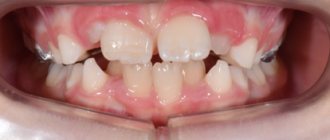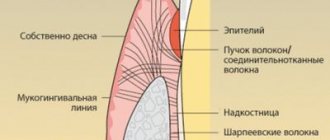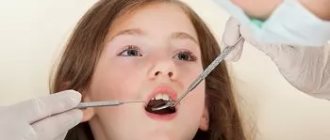A small chin (medically called inferior micrognathia, or microgenia) is an incredibly common problem.
However, most people who can be confidently diagnosed with this have not only not heard such words, but also do not suspect that there is anything wrong with them. They are healthy, everything is in place. But no matter how hard they try to achieve an ideal appearance, it doesn’t work!
Neither losing weight, nor taking care of your face, nor changing your hairstyle helps. It's not clear what's going on! As a result, people either come to terms with the fact that everyone is imperfect, or they suffer all their lives because the ideal is unattainable for them personally.
Reasons for the development of micrognathia
Anomalies of jaw development can be congenital or acquired.
Congenital ones include:
- Severe acute illnesses of a woman during pregnancy,
- Anomalies of intrauterine development of the fetus,
- Congenital pathologies of the development of the dental system,
- Genetic predisposition.
An acquired anomaly can result from:
- Maxillofacial trauma,
- Artificial feeding and improper sucking in infancy,
- Diseases of the endocrine system,
- Past infectious diseases and inflammatory processes,
- Early loss of baby teeth,
- Problems with nasal breathing.
Which prosthetics are better for complete edentia?
Classic removable dentures are affordable, but they are not able to provide everything necessary for a high quality of life:
- functionality;
- comfort to wear;
- quality of chewing food;
- healthy load on the jaw;
- restoration of the natural shape of the face.
This is a half-measure that does not allow us to fully restore a decent quality of life. This is why dental implantation is the best solution for complete edentia. Computer modeling methods allow you to understand what your smile and overall face will look like even before implants and prostheses are installed. At the same time, computer programs help to accurately determine the location of future implants to restore the natural shape of the face, eliminate deep wrinkles, hollow lips and cheeks caused by missing teeth.
In case of complete absence of teeth, two concepts of implantological treatment are provided: classical and mini-implantation.
With mini-implantation, which is considered a temporary solution, the prosthesis is installed immediately after implantation. With mini-implantation, only removable prosthetics are available, and the design is inferior to classical prosthetics in terms of reliability and durability.
In the classic version, the patient undergoes the procedure of engrafting several implants - artificial roots made of titanium, which will serve as support for the future prosthesis. To securely attach the prosthesis, a minimum of 4 implants are required in the upper jaw and 3 in the lower jaw. But in a number of clinical cases, to achieve better stability, it is recommended to use a larger number of implants. After 6 months, when the implants have finally taken root, a permanent prosthesis is installed on them.
Diagnosis and treatment of narrow jaw
Deformed dentition, crowded teeth, malocclusion, unerupted teeth are consequences of an underdeveloped dental system. The earlier these abnormalities are diagnosed, the more effective the treatment will be. To expand the lower and upper jaws, therapeutic methods, mechanical expanders and plates are used. In rare cases, only surgery helps.
In children under 10-11 years old, jaw expansion gives the best results. This is a time of active growth and formation of bone tissue, so the defect can be corrected with the help of orthodontic structures.
Micrognathia - symptoms and treatment
Almost every type of dysgnathia and micrognathia is accompanied by very specific and noticeable functional and aesthetic disorders. These include all cases of malocclusion: from mesial, when the lower teeth protrude forward relative to the upper ones, to any variants of distal occlusion, in which the lower row of teeth is much behind the upper row. Such malocclusions are always accompanied by certain negative manifestations:
- from the teeth: abrasion, carious lesions, periodontal diseases;
- from the dentition: crowding and compensatory disorders (narrowing of the dentition and its curvature);
- from the temporomandibular joints: pain, clicking, crepitus (crunching sound), limitation of movements.
With skeletal disorders associated with a decrease in the upper respiratory spaces due to the small size of the supporting structures of the upper and lower jaws, a frequent manifestation of the pathology is breathing obstruction syndromes during sleep, for example sleep apnea.
Obstructive sleep apnea is a potentially life-threatening condition. It is characterized by snoring and repeated cycles of cessation of breathing during sleep. Most often, the pathology is associated with a narrowing of the respiratory space caused by improper bite and position of the jaw bones. In addition to snoring with pauses in breathing and night pain in the chest area, sleep apnea is accompanied by a decrease in oxygen levels in the blood, severely fragmented sleep, excessive daytime sleepiness, migraines and irritability.
Despite the listed functional disorders, the most significant clinical manifestation of dysgnathia and micrognathia is the aesthetic component . It is dissatisfaction with the smile and face that forces patients to seek medical help. While the intervention of an orthodontist and/or orthopedic dentist is often sufficient to correct a smile, the help of an oral and maxillofacial surgeon is necessary to restore the aesthetic balance of the face [11].
The main signs of severe underdevelopment of the jaw can usually be seen with the naked eye. These include:
- disproportionate features, distortion of facial contours;
- malocclusion;
- retraction of the upper or lower lip;
- a slanted (“bird-like”) or protruding chin;
- wrinkled skin of the chin, etc.
Severe micrognathia is clearly visible from the outside, but in the early stages only a doctor can diagnose underdevelopment of the jaw bones.
Expansion of the lower jaw
A narrow lower jaw, or microgenia, can be corrected in childhood with special devices - distractors. This is a device that gradually stretches the bones of the lower jaw. New bone and soft tissue grows at the site of the sprain. When installing a distractor, first increase the distance between the canines of the lower jaw. Every day the device allows you to increase the lower jaw by 1 mm. When the jaw is wide enough to accommodate tooth growth, the distractor is placed in place for at least two weeks to stabilize the sprain.
If you have a problem similar to that described in this article, be sure to contact our specialists. Don't diagnose yourself!
Why you should call us now:
- We will answer all your questions in 3 minutes
- Free consultation
- The average work experience of doctors is 12 years
- Convenient location of clinics
Single contact phone number: +7
Make an appointment
In adult patients, the lower jaw bones are fused and cannot be stretched, as in children. Therefore, to enlarge the lower jaw, the surgeon cuts the bone in several places with an ultrasonic knife. On the fourth day after surgery, an expansion device is installed. The first adjustment of the stretching is carried out by an orthodontist, then the patient himself controls the stretching process, which can take up to six months.
After expanding the lower jaw, braces are installed on the lower front teeth to correct the bite. Crowded teeth gradually occupy the resulting space.
The photo below shows a narrow jaw before and after expansion.
What is microgenia (micrognathia) of the lower jaw
Microgenia of the lower jaw is nothing more than a small underdeveloped chin. A defect in appearance caused by a lack of bone in the chin area.
A young girl contacted Platiennetal with complaints about a small chin and asymmetry of the chin area.
A chin augmentation was performed using a Porex implant, Bisha's fat bags in the cheek area were partially removed. It was possible to visually narrow and “stretch” the oval of the face, making it harmonious.
Performed by: plastic surgeon Andrey Iskornev
Photo from the patient’s personal archive. Surgeon: Iskornev A.A.
Performed: upper blepharoplasty, ️installation of a chin implant, medial and lateral platysmaplasty with neck lift through an incision in the earlobe. Performed by a surgeon - Maxim Vasiliev .
A small or sloping chin spoils any face. And if a small chin in men can still be hidden under a thick beard (for those who find the strength to wear this “decoration”, which makes the owner look ten years older), then a small chin in women cannot be disguised.
Looking at a human face, we often see only the whole and do not notice the details.
A short chin in itself is not noticeable and is not perceived as a flaw. But with its size it violates the proportions. From the side, a fuzzy oval of the face, early wrinkles, folds on the neck and a premature double chin are visible. And only a specialist - a maxillofacial surgeon or an orthodontist - will understand that the reason is the insufficient size of the chin.
One jaw is smaller than the other
Micrognathia is a congenital pathology in which the jaw bone is underdeveloped and one jaw is smaller than the other. Pathology happens:
- top and bottom;
- one-sided and two-sided;
- symmetrical and asymmetrical;
- pronounced and weakly expressed.
Signs of pathology in the lower jaw are very difficult to miss - the face becomes like a bird's head, the lower lip and chin recede. In addition, the lower jaw is inactive, making it difficult for the patient to bite, chew and swallow food. All this may be accompanied by bite pathology.
Signs of upper micrognathia - the teeth of the upper jaw are located at an angle, the lower dental units are pushed forward. Due to this abnormal growth of teeth, the face may be asymmetrical.
Reasons for the development of pathology:
- unbalanced diet of the expectant mother;
- injury to the fetus during pregnancy;
- untimely loss of milk or permanent units;
- thyroid diseases;
- congenital defect of the maxillofacial region;
- improper breathing through the nose;
- genetic predisposition.
In addition to a reduced jaw, it may also be too enlarged. The disease is called macrognathia. The lower jaw is more susceptible to pathology, less often the upper jaw, and the disease can also be of a mixed type.
Inferior macrognathia is the most common. The disease is characterized by excessive development of the lower jaw, both in length and width. The upper jaw develops without deviation, and the face becomes asymmetrical. Over time, gaps between the teeth and a deep diastema appear in the dentition. The teeth do not close normally, chewing function is impaired.
How does maxillary macrognathia manifest itself?
- the middle part of the face is strongly pushed forward;
- lower lip sinks;
- Gaps and diastema appear.
Macrognathia of the upper jaw causes the following problems:
- problems with biting and chewing food;
- improper breathing;
- speech disorder.
Missing teeth: health at risk
Edentia is the absence of teeth, which does not allow a person to live a full life. First of all, health problems arise not only in the oral cavity, but also in other areas.
Due to the disease, a person loses:
- bone and muscle tone;
- symmetry of the face and jaw;
- anatomically correct bite;
- the opportunity to eat well and much more.
The absence of one tooth, for example, on the top row gradually forces the “neighbors” to shift towards free space. There is a curvature of the entire dentition, the distribution of the chewing load changes, the destruction of bone tissue and its natural loss. If there is free space in the oral cavity for a long time and a person does not visit the dentist to correct the situation, the teeth develop pathological abrasion and hypersensitivity. And if you have lost more than 10-12 teeth in a row, you can easily develop subluxation of the lower jaw. In the case of complete edentia, the situation looks even more critical.
So what are the consequences of long-term absence of teeth in the oral cavity? Let's look at the example of your health.
Curvature and tooth decay
One tooth that you have lost entails a restructuring of the entire dentition. In free space, units move apart or turn around, sway and lose support in the neighborhood. All this leads to a change in bite, and then to problems with the maxillofacial joint. By the way, problems in this area can also affect the neck, head and back. You can get another not very pleasant disease in addition to problems in the oral cavity.
In addition, pieces of food may remain in the “voids” in the jaw. Microorganisms form in these accumulations, and then caries and inflammatory processes in the mouth form. So, in addition to truly crooked and loose teeth, you can get a number of soft tissue diseases.
Gum tissue is affected
Once the process of tooth decay begins, problems with the gums and soft tissues in the oral cavity follow. And soda solution will not help here! The epithelium (top layer) becomes thinner over time and may disappear almost completely. In this case, some experts recommend bone augmentation - not the most pleasant operation for the patient. It is done before installing implants and prostheses, however, the rehabilitation process after bone tissue augmentation takes up to six months.
And the affected soft tissues directly affect food intake. Difficulties in digestion aggravate the situation with the gums, resulting in a vicious circle.
Eating problems
The gastrointestinal tract is the next system in the body that is affected by adentia. Poor digestion of food and its poor absorption become the main problems for humans. The absence of teeth and chewing with the “gum” force you to change your diet towards liquid foods and a variety of purees. Chewing your favorite meat becomes increasingly difficult or even impossible. A complete transition to “soft” food provokes a problem associated with the functioning of the gastrointestinal tract. Gastritis, colitis and other unpleasant diseases occur.
Thus, from a health point of view, you lose not only your teeth, but also an elementary way to eat normally, eat your favorite foods and constantly control yourself in taste preferences. Unpleasant sensations in the oral cavity, diseases of soft tissues after treatment can occur again and again until the problem is radically solved - installing a fixed prosthesis. All-on-4 technology allows you to get your teeth back in 1 day and correct all the health problems that the patient developed while delaying his treatment.
Want to know how? Call the hotline of the Teeth in 1 Day clinic network and we will tell you all the details about the fixed prosthetics system!
An integrated approach to the treatment of dental anomalies in children aged 9 to 13 years
One of the common reasons for the formation of complexes in children and adolescents is the unsatisfactory appearance of the smile and teeth. Children are known to be especially cruel to each other. And a child/teenager who does not stand out favorably from his environment often becomes the subject of ridicule from his peers. And if many imperfections can be successfully hidden, then problems with the visible part of the teeth and smile are quite difficult to disguise. As a result, children withdraw from society and withdraw into themselves. Acquired disorders of facial expression and articulation appear.
I want to share with you the story of one orthodontic treatment, where I had to act as a doctor, psychologist and teacher.
Patient A. born 2004. came to me for consultation at the age of 9 years.
Diagnosis: narrowing of the upper and lower jaw, crowded position of the teeth on the upper and lower jaw in the frontal area, palatal position of 1.2 teeth, multiple caries, poor oral hygiene (photo 1).
Initially, professional hygiene and sanitation were carried out, as well as training in the rules of brushing teeth at home.
Then a removable plate apparatus was made for the upper jaw with bite pads in the area of the lateral teeth, a spring-shaped point for 1.2 teeth, an expanding screw and a vestibular arch.
The use of the device lasted 2.5 months, until tooth 1.2 was removed from the block and the upper jaw was slightly expanded (photo 2).
The device was lost and an unplanned break of several months followed, but then we still managed to continue working. Treatment of caries of 1.6 and 4.6 teeth was carried out. Installation of a conditionally removable Quad Helyx device (photo 3). Activation for expansion and smooth derotation of molars.
It is also worth noting that the success of treatment in the first stages was overshadowed by the patient’s low responsibility regarding hygiene and the inability of parents to attend follow-up examinations in a timely manner. I had to do active psychological and pedagogical work in order to move on to the further stage of treatment with the brace system. And 6 - 7 months later, after fixing the Quad Helyx, a ligature bracket system was installed (photos 4, 5).
In this case, a non-standard (even slightly contradictory) treatment tactic was used. Already at the leveling stage, opening springs were connected with thin arcs in the area of 1.4 - 1.2 teeth and 4.2 - 4.4 teeth to create space for teeth 1.3 and 4.3, respectively (photo 6).
Next, a “window” was created on the mucosa in the projection of the crown of 1.3 teeth - a small “temporary” bracket was glued (as an alternative to an orthodontic button) and a weak extrusion traction was connected (photo 7).
As the permanent teeth erupted, they were also included in the brace system and smoothly placed in the dental arch (photos 7, 8, 9, 10). During each appointment, I noted the same poor hygiene and continued to carry out psychological work. I had to repeatedly “threaten” to stop treatment. But responsibility for the aesthetic future of the young patient’s smile did not allow me to do this.
After normalizing the position of all teeth and creating adequate occlusion, a joint decision was made to stop orthodontic treatment so as not to aggravate the condition of the already weakened enamel.
Next, remove the bracket system, grind and polish the surface of the teeth, manufacture and fixation of permanent retainers to areas 1.3 - 2.3 and 3.3 - 4.3 teeth (photo 11, 12, 13).
Of course, as you can see, there are still areas that would ideally require orthodontic correction. But personally, I think that this result can be considered acceptable and satisfactory. The result is a beautiful smile, complete aesthetic rehabilitation, psychological stability and hints at normalizing hygiene. Ahead is a course of remineralizing therapy, quality control of oral hygiene, and replacement of failed fillings. And today there is a brilliant smile of a confident young man (photo 14).
Micrognathia and macrognathia: treatment
Since a child is often born with this anomaly, doctors recommend using special pacifiers and nipples in the first year of life.
For the treatment of micrognathia and macrognathia in adults, different orthodontic structures are used:
- Katz guide crown;
- chin sling;
- corrective mouthguards;
- special plate with a pull-out.
If treatment with this method does not produce results, surgical intervention is possible: the bone is cut and reconnected, the jaw is fixed with a splint so that the bones grow together correctly. This operation can be performed by either a surgeon or an orthodontist. Some dental clinics are engaged in correcting underdevelopment of the lower jaw and other pathologies described above.
The iOrtho clinic network provides high-quality services for correcting malocclusion with Invisalign aligners, sign up for a consultation now!
What is secondary edentia
Why, with partial edentia, teeth cannot fully perform the chewing function?
What does partial adentia lead to?
In dental practice, a situation often occurs when a patient is missing several teeth and one could say that this is partial adentia, BUT the remaining teeth are in such a deplorable condition that they cannot perform their natural functions, and in this case it would also be complete edentia, i.e. lack of teeth for chewing food.
On the picture
- partial edentia











